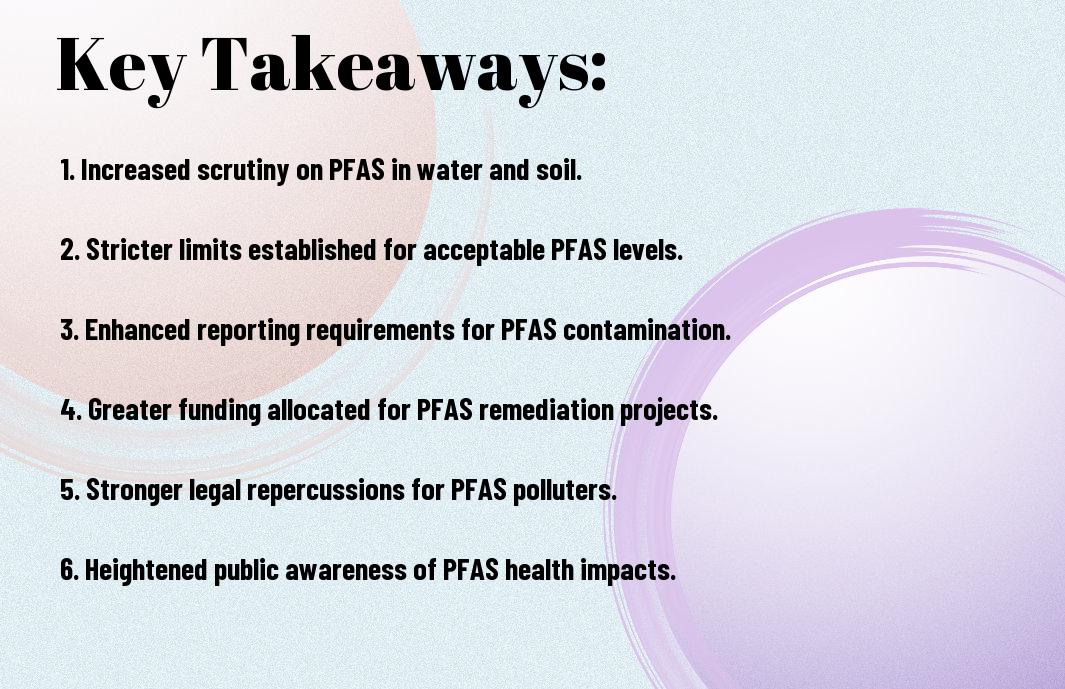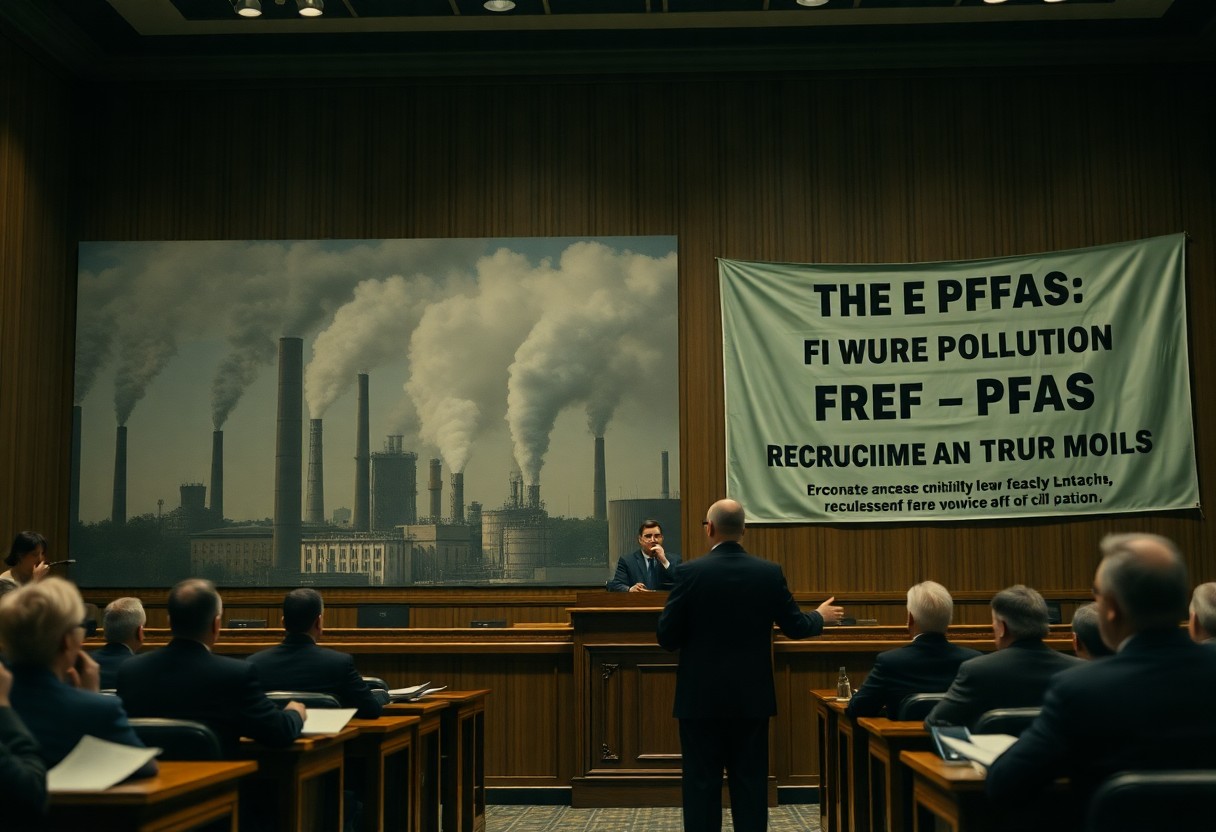It’s imperative to understand how recent lawsuits surrounding per- and polyfluoroalkyl substances (PFAS) have reshaped environmental regulations. As you navigate through these changes, you will find that growing public awareness and legal actions against major corporations have pressured regulatory agencies to tighten standards governing these chemicals. This post will explore the implications of these lawsuits on environmental policies and what it means for your community and health moving forward.
Overview of PFAS and Their Environmental Impact
To understand the environmental impact of PFAS, it’s important to recognize how widespread these substances are. Known as “forever chemicals,” PFAS are synthetic compounds that resist degradation, leading to persistent contamination in soil, water, and air. Their accumulation poses risks to ecosystems and human health, prompting increases in regulatory measures.
Definition and Types of PFAS
To define PFAS, they are a group of over 4,700 chemical substances used for their water- and grease-resistant properties.
- Perfluorooctanoic acid (PFOA)
- Perfluorooctane sulfonate (PFOS)
- Perfluorobutane sulfonic acid (PFBS)
- Perfluorohexane sulfonic acid (PFHxS)
- GenX Chemicals
This diversity contributes to their widespread use and subsequent environmental challenges.
| Type of PFAS | Common Use |
|---|---|
| PFOA | Stain-resistant fabrics |
| PFOS | Firefighting foams |
| PFBS | Food packaging |
| PFHxS | Waterproofing agents |
| GenX Chemicals | Replacement for PFOA |
Sources of Contamination
Overview of contamination sources includes industrial discharges, household products, and agricultural runoff. PFAS can infiltrate drinking water supplies and ecosystems through various pathways, making mitigation efforts increasingly vital to preserve public health and environmental integrity.
PFAS contamination often arises from industrial activities, specifically in manufacturing processes and waste disposal. Additionally, products containing PFAS, such as textiles, fast food packaging, and non-stick cookware, can release these substances into the environment. Runoff from agricultural practices, where PFAS-laden biosolids are utilized as fertilizers, further exacerbates contamination. Being aware of these sources can enable you to take necessary precautions in safeguarding your health and environment.
Recent Trends in PFAS Lawsuits
While the past few years have seen a significant rise in PFAS-related lawsuits, these legal actions have sparked ongoing discussions about environmental regulations. You may notice that affected communities are increasingly pursuing claims against manufacturers, resulting in settlements and regulatory changes at various levels of government. This trend highlights the growing concern surrounding PFAS contamination and its implications for public health and safety.
Key Cases and Their Outcomes
On notable occasions, lawsuits against major chemical companies have yielded substantial settlements, which further emphasize the need for stricter regulations. You might see cases resulting in millions awarded to municipalities for cleanup costs and health assessments, ultimately pushing regulatory bodies to reconsider existing PFAS guidelines.
Impact on Public Awareness and Perception
Cases involving PFAS have brought significant attention to the dangers of these substances, leading to a shift in public perception regarding environmental safety. You may find people are now more informed about the potential risks associated with PFAS, prompting discussions about policy changes and regulations.
Awareness of PFAS issues has significantly increased among the general public, affecting how you perceive environmental regulations and corporate accountability. As cases gain media coverage, you may feel compelled to advocate for stronger protections and engage with local communities facing contamination. This heightened awareness influences your understanding of public health and encourages you to support initiatives aimed at reducing PFAS exposure in your environment.
Changes in Environmental Regulations
Some of the recent PFAS lawsuits have led to significant adjustments in environmental regulations aimed at better protecting public health and the environment. These changes reflect a growing recognition of the dangers posed by per- and polyfluoroalkyl substances, prompting policymakers at various levels to reconsider and often tighten existing laws and guidelines regarding chemical safety, water quality, and industrial practices.
Federal Level Adjustments
Alongside state-specific measures, federal regulations have also evolved in response to PFAS lawsuits. The Environmental Protection Agency (EPA) has taken initiatives to establish stricter guidelines for PFAS exposure, pushing for more robust testing and reporting requirements. This has resulted in a more comprehensive framework for accountability, compelling manufacturers to disclose levels of PFAS in their products and reducing permissible limits in drinking water.
State-Level Initiatives
Regulations at the state level have also been proactive in addressing PFAS contamination by implementing bans on certain uses of these chemicals, setting enforceable drinking water standards, and mandating cleanup protocols for contaminated sites. This decentralized approach allows states to fine-tune their regulations based on local conditions and concerns, often leading to more stringent protections for their residents.
Plus, many states have begun to fund initiatives aimed at reducing PFAS contamination and enhancing public awareness. This includes investing in advanced water treatment technologies, conducting comprehensive studies to assess the extent of PFAS pollution, and establishing educational programs to inform the public about potential risks. As states mobilize resources to tackle these challenges, you could see a more cohesive approach that embraces cutting-edge science and community involvement for a healthier environment.

The Role of Science in Regulation Changes
For those closely monitoring environmental issues, the evolving role of science in shaping regulations is noteworthy. Scientific advancements have prompted the reevaluation of acceptable levels of PFAS exposure, leading to stricter guidelines. In this evolving landscape, you may find that empirical data is becoming pivotal in informing policy decisions, pushing for a more transparent and evidence-based regulatory framework.
Advances in Detection and Risk Assessment
About recent years, significant strides have been made in detecting PFAS in various environments. Improved analytical techniques enable scientists to identify lower concentrations of these compounds, enhancing risk assessments. With greater accuracy in measurement, you can expect authorities to adjust regulatory standards, ensuring better protection of public health and ecosystems.
Long-term Health Studies and Their Implications
Along with advancements in detection, long-term health studies have underscored the consequences of PFAS exposure. These studies highlight the potential for chronic health issues linked to PFAS, prompting a call for stricter regulations. As you learn more about these implications, you may see increased advocacy for policies that address not only current risks but also long-lasting effects on communities.
Long-term studies have consistently revealed that the impact of PFAS can extend over decades, leading to various health problems such as immune dysfunction, reproductive issues, and certain cancers. As you assess these findings, it becomes apparent that the need for comprehensive regulatory responses is pressing. These studies not only inform legislation but also emphasize the importance of preventative measures to protect you and your environment from future harm.
Industry Responses to Regulatory Changes
Unlike prior years, many industries are now adjusting their practices in response to stringent PFAS regulations. Companies are adopting more transparent reporting methods and ensuring compliance with the latest environmental standards to mitigate potential legal risks. This shift not only affects production processes but also pushes organizations to collaborate with regulators, stakeholders, and communities to foster a more sustainable operational model.
Corporate Accountability and Liability
Changes in regulations have led to heightened corporate accountability and expanded liability for PFAS contamination. Companies are now facing increased scrutiny over their environmental impact, prompting many businesses to reevaluate their practices and implement comprehensive risk management strategies. This proactive approach aims to safeguard both public health and the company’s brand reputation.
Innovations in PFAS-Free Alternatives
Changes in regulatory pressure have spurred innovations in PFAS-free alternatives across various industries. Companies are investing in research and development to create safer, sustainable products that meet consumer demand while adhering to environmental standards.
Considering the growing awareness of PFAS-related health issues, the need for effective and eco-friendly alternatives has never been more pressing. Businesses are exploring innovative materials that provide the same functionality as traditional PFAS products without the associated risks. These advancements not only promote environmental sustainability but also enhance brand loyalty among consumers who prioritize health and safety in their purchasing decisions.
Looking Ahead: Future Challenges and Opportunities
Now, as environmental regulations continue to evolve in response to PFAS litigation, you should be aware of both the challenges and opportunities that lie ahead. Emerging technologies for PFAS detection and remediation offer exciting prospects for tackling contamination. At the same time, regulatory compliance may become more rigorous, requiring you to adapt your strategies to meet new standards. Staying informed and proactive will be imperative in navigating this shifting landscape, enabling you to contribute positively to environmental protection while ensuring your operations remain compliant and sustainable.

Summing up
From above, you can see how recent PFAS lawsuits have significantly impacted environmental regulations by prompting stricter standards and increased accountability for chemical manufacturers. As you navigate this evolving landscape, it’s important to recognize that these legal actions not only heighten awareness of PFAS risks but also drive policy changes aimed at protecting public health and the environment. Staying informed about these developments will help you understand your rights and responsibilities as a stakeholder in this critical issue.














